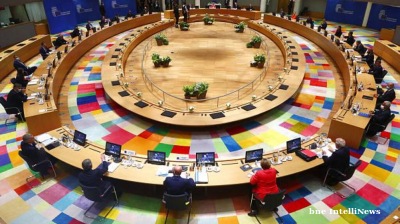Ed – this article is part of the “UKRAINE REMONT” series covering the reconstruction of the Ukrainian economy.
Ukraine’s construction industry is resilient as it gears up for the restoration of the country’s decimated housing and infrastructure. But the sector has a mountain to climb as it contends with shortages of material, labour and peace.
According to the World Bank’s most recent Rapid Damage and Needs Assessment report (RDNA4), around 13% of the country’s housing stock has been destroyed or damaged, affecting 2.5mn households. As of November 2024, 236,000 residential buildings have been damaged or destroyed, including 209,000 private houses, 27,000 apartment buildings and 600 dormitories, according to the KSE Institute.
Damage to housing amounts to approximately $60bn, or a third of the total damage inflicted on buildings and infrastructure, making housing the worst affected sector. Damage to transport and energy infrastructure respectively account for 21% and 12% of the total damage.
The healthcare system has suffered with 1,603 healthcare facilities (16.2% of the total) destroyed or damaged, while over 10% of education infrastructure has been damaged or destroyed. The war also wiped out a significant proportion of Ukraine’s warehouse capacity, with around a fifth lost to destruction or occupation.
In total, the estimated cost of damage to Ukraine's infrastructure and buildings stands at approximately $176bn, according to RDNA4.
Wartime construction
Despite the extremely challenging circumstances, the first green shoots of a recovery have appeared in the real estate development industry.
"In Kyiv and central Ukraine, the market decreased substantially, maybe [by] 30-40%, but there is still some activity, and large developers are continuing their projects. In western Ukraine, actually, the market is even above pre-2022 conditions," explains Max Nefyodov, co-founder of Technology of Progress and former Deputy Minister of Economy.
This regional disparity is reflected in official statistics. According to the State Statistics Service, in 2024 housing construction in Ukraine increased by 21.1% compared to 2023. Last year saw 118,400 apartments built, with just over a third (43,100) of these appearing in Kyiv and the surrounding region.
“Western Ukraine has now become a big construction site. We see that there is active hotel and recreational construction in the Carpathians and industrial construction for agro- and food enterprises,” Vitaliy Pritula, director of Eurometal, told the GMK Center.
2025 will see a record number of warehouses built in Ukraine, with a possible 500,000 square metres of warehouse space estimated to be commissioned. Less optimistic estimates put the figure at closer to 270,000 sqm, but this would still represent the largest volume of new supply in over a decade, according to Delo.ua.
CBRE Ukraine has also reported what it describes as a “healthy recovery” in the commercial real estate market in Kyiv in the second half of 2024, with the volume of retail turnover increasing 13% year on year.
However, market conditions remain volatile. "It literally fluctuates month to month," Nefyodov points out. "When there were these discussions about a potential quick peace deal, there was a surge of optimism, which lasted for a couple of weeks. Then there was, obviously, a down-hill trend, and there was a couple of weeks of complete pessimism.”
According to Nefyodov, the construction work that is happening is relatively small-scale and focused on maintenance and repair: “"You shouldn't talk about this as some kind of big rebuilding or reconstruction. It is just construction that is happening. Hospitals and schools and houses and roads and bridges are being maintained.”
Materials, labour and power shortages
Plans for large-scale reconstruction must contend with a shortage of construction materials. The construction materials sector has itself suffered from the war, with around 15% of producers suffering varying degrees of damage, according to the Institute for International Economic Research. The war has also seen the share of imported materials in the Ukrainian market rise, from 14% in 2021 to 23% in 2023, according to the KSE Institute.
"There are many types of materials where there are shortages even now. And there definitely will be more shortages if we talk about expansion of the construction market," noted Nefyodov.
In order to rebuild, Ukraine will need to produce as much of the necessary materials domestically. According to the KSE Institute, around 60% of the cost of residential real estate construction is related to the cost of materials, and importing these from abroad is time-consuming and expensive.
Russia’s war has exacerbated this problem through the destruction of several important domestic producers. Ukraine’s one sheet glass-producing facility was destroyed in 2014, and the country is currently entirely reliant on imports.
Additionally, existing production capacities for cement (current capacity 13mn tonnes vs. the required 14-15mn tonnes), concrete (12mn cubic metres vs. the required 21-22 mcm), mineral wool (35mn sqm vs. needed 49-50mn sqm) and PVC profiles (current working capacity 15mn linear metres vs. needed 19.5mn metres) are insufficient to meet the expected reconstruction demand.
According to a study conducted by the Institute for International Economic Research, about 90% of the building materials needed for reconstruction can be manufactured within Ukraine, and several companies, both domestic and international, are investing in new production facilities to address these shortages.
Austrian manufacturer Kronospan opened a €200m facility in Rivne in December 2024 making oriented strand board. German building materials giant Knauf is currently building a €150m drywall and dry building mixtures plant in Ternopil, which will open at the end of 2025. Two sheet glass factories are currently under construction with a joint capacity of 30mn sqm, which will cover most of Ukraine's needs.
The workforce situation is equally challenging. According to the Confederation of Employers of Ukraine, the number of officially registered workers in the construction sector has decreased by 25.4% over the past two years.
Particularly acute are shortages of specialised labourers such as bricklayers and electricians, with vacancy rates around 30-40%, according to Olga Gavura, director of construction company 7CI Group, as quoted in Forbes Ukraine.
"People are being drafted to the army. A lot of people have had to immigrate, and a lot of women went out of the labour market because they have to stay with their kids in Poland or Germany or Czech Republic," explains Nefyodov. "Ukraine, unfortunately, doesn't have great demographic trends, the same as Western Europe, which means that there is a shortage of qualified personnel."
While material and labour shortages pose significant challenges, Nefyodov stresses that the overwhelming obstacle is security. "The one major challenge is military risks," he states. "Other things can be quantifiable. Yes, there are challenges with manpower, challenges with logistics and so on. But these are challenges. You can quantify them and then you can make an investment case. But you can't make an investment case for Putin launching a rocket at your factory."
This unpredictability particularly affects manufacturers requiring continuous operations. "If you produce glass... once a float glass plant starts, it never stops. If you have electricity shortages and it needs to stop, it's a huge loss, a huge problem, and basically you need to rebuild a lot of equipment from scratch," Nefyodov pointed out.
Government support and funding realities
In 2024, at least $1.2bn was disbursed from the state budget and donor funds for housing sector recovery.
The Ukrainian government has focused on targeted emergency assistance through its eRecovery platform, launched in May 2023. "There is the programme on eRecovery where people can apply for compensations for damages. They've been allocated relatively small amounts for repairs of individual houses or if the glass in the window was destroyed," Nefyodov explains. On April 2, the government approved a €100mn loan from the Council of Europe Development Bank to compensate owners of destroyed homes. 2,800 households were issued grants under this programme in 2024, with additional funding for a further 3,600.
However, the scale of funding needed for comprehensive reconstruction far exceeds Ukraine's resources. "Obviously, the country doesn't have $590bn only to rebuild what was destroyed by Russians," notes Nefyodov. "The number one and easiest solution for everyone would have been to confiscate frozen Russian assets and to use them to compensate for the damage that Russia caused.”
With approximately 50% of Ukraine's budget already allocated to defence, there is little capacity for the government to stimulate construction more broadly. "It's not like you can subsidise or give out free mortgages or something," Nefyodov pointed out. Government intervention is therefore focused on "urgent repairs where it needs to be done because if the building [has] lost a roof and you don't repair it immediately, then winter comes and the building will be completely destroyed."
Planning for reconstruction
There is cautious optimism about the sector's future once hostilities end. The Ukrainian government is taking steps to prepare for larger-scale reconstruction, including establishing a central procurement organisation specifically for construction works to achieve economies of scale and attract major international contractors.
“Large foreign contractors like DaVinci, Halliburton don't want to repair one school. But if you compile 50 schools together, that's interesting for them and they can look at it. So yes, definitely, after the hostilities come to some kind of resolution, there is potential for substantial growth in this sector,” said Nefyodov.
Features

Trump eyes Bagram return, with China in his sights
In the years it was operational, 14 nations operated at, or through Bagram. In addition to the US, these included UK forces and elements from France, Germany, South Korea and more.

$23bn windfall for Kazakhstan as Beijing shifts up a gear on New Silk Road
Resource-rich Central Asian country emerges as a standout destination for Chinese investment.

US cancels Chabahar port sanctions exemption in blow to India's regional strategy
US terminates Iran Chabahar port sanctions waiver from September 29, jeopardising India's strategic trade operations and regional connectivity initiatives through the key facility.

INTERVIEW: Moldova seizes its moment
From rapid progress towards EU accession to the reconstruction of neighbouring Ukraine, factors have aligned to make Moldova an attractive FDI destination, says Invest Moldova head Natalia Bejan.




